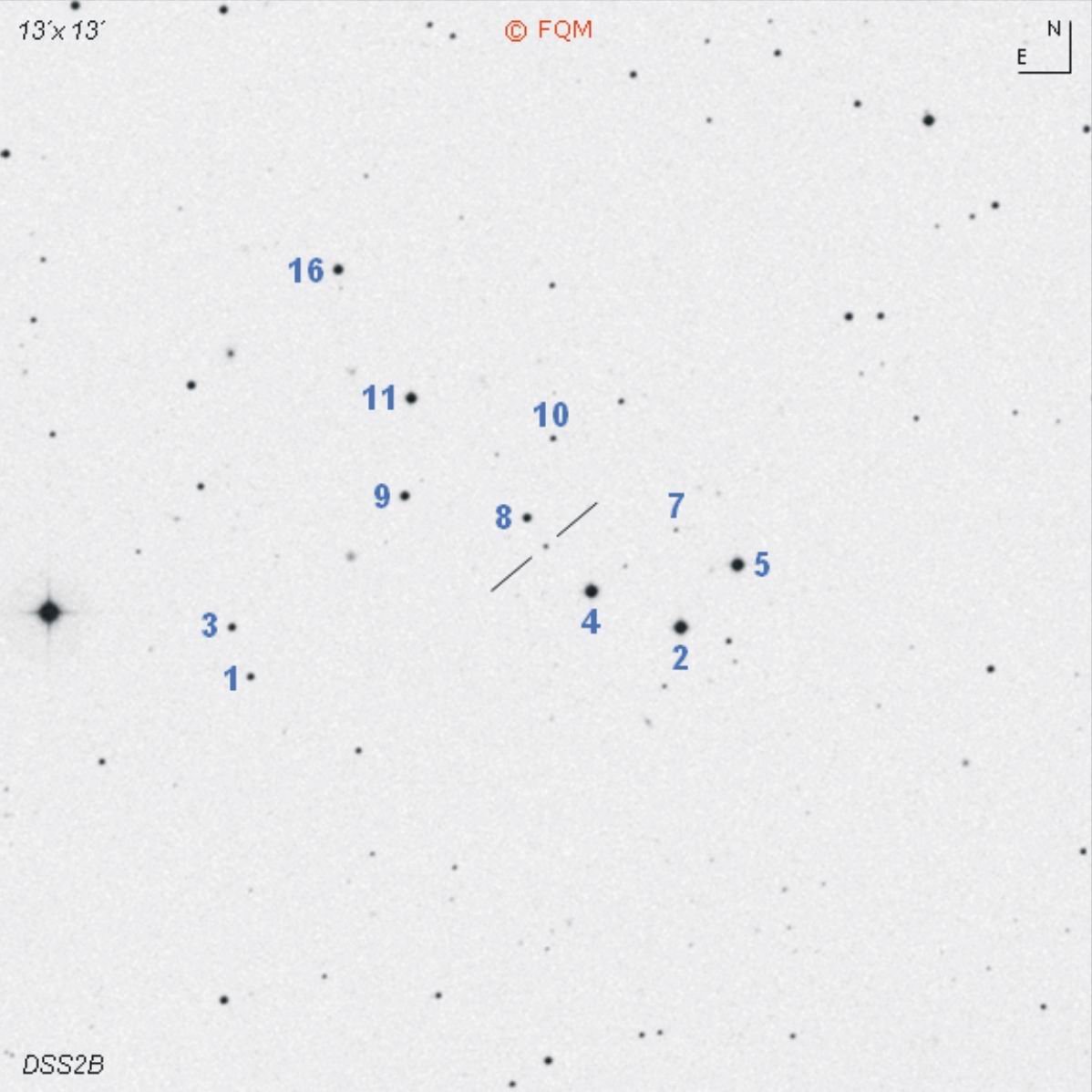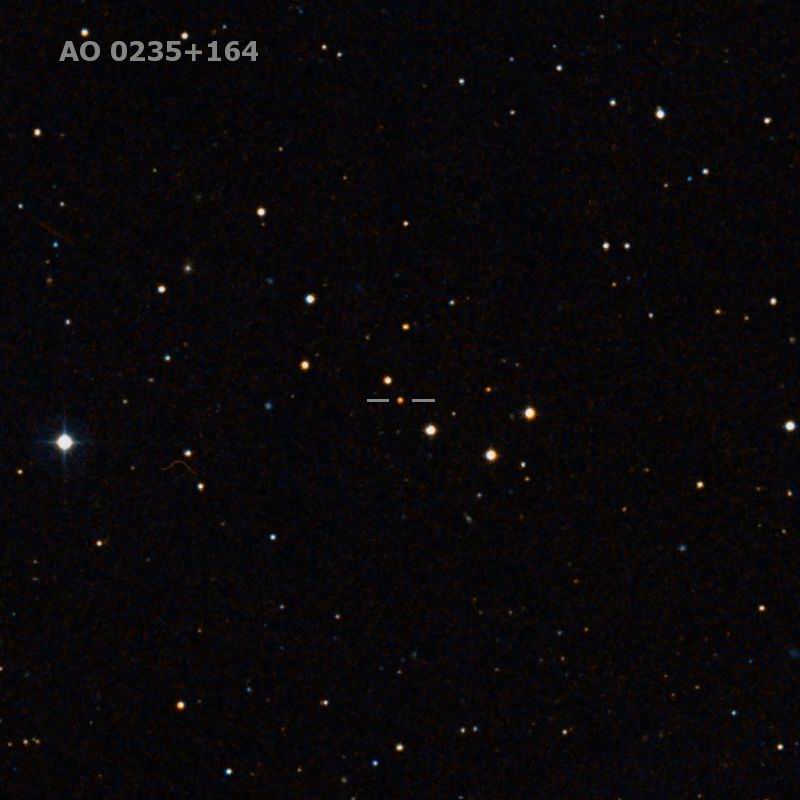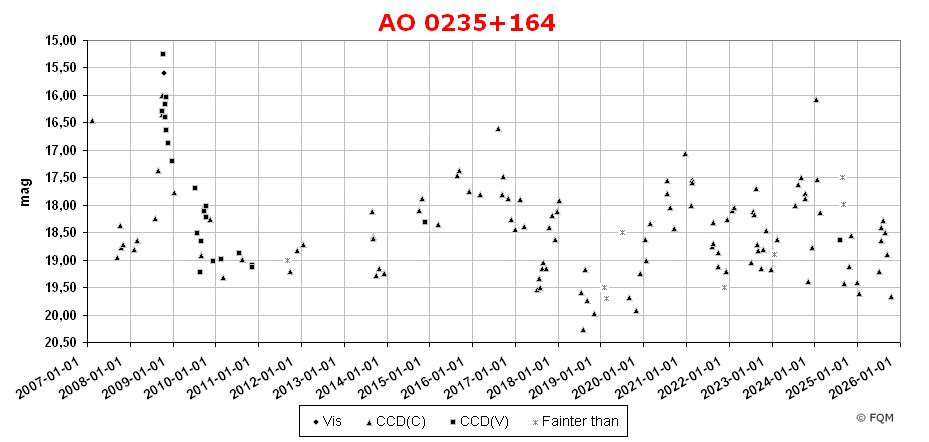
| Frankfurt Quasar Monitoring |
| AO 0235+164 |
| Cross-Identifications |
PKS 0235+164, AO 0235+16, GC 0235+16, 0235+164 OD+160, 2MASSi J0238389+163659, TXS 0235+164 MG J0238+1636, WMAP J0238+1636, 1ES 0235+164 87GB 023552.1+162405, GB6 J0238+1637 1AXG J023838+1636, GEV J0237+1648 EGRET J0238+1657, 3EG J0237+1635 |
| Equat. coordinates | RA 02 38 38.9 DE +16 37 00 (J2000) |
| Constellation | Aries |
| Type | BL Lac (3) / QSO (1) |
|
Redshift |
z=0.940 |
| Distance (2) (4) | 3077 Mpc |
| Total mag range (mv) (5) | 14.3 - 20.0 |
| Catalog Magnitude | 15.50 (1) / 18.0 (2) |
| Absolute Magnitude (1) | -27.6 MB |
| Light Travel-Time (2) | 7.272 × 109 yrs |

Comparison stars
| star | B | V | Rc | Ic |
| 1 | ---- |
16.209 (0.091) |
15.506 (0.024) |
15.170 (0.022) |
| 2 | 13.540 (0.002) |
12.720 (0.002) |
12.137 (0.001) |
---- |
| 3 | 16.487 (0.032) |
15.978 (0.014) |
15.589 (0.008) |
15.208 (0.023) |
| 4 | 13.599 (0.002) |
13.037 (0.002) |
12.678 (0.029) |
12.373 (0.000) |
| 5 | 13.673 (0.001) |
12.936 (0.000) |
---- | ---- |
| 7 | 20.126 (0.224) | 18.262 (0.018) | ---- | ----
|
| 8 | 16.181 (0.009) |
15.025 (0.014) |
14.203 (0.006) |
13.731 (0.010) |
| 9 | 15.773 (0.020) |
14.781 (0.022) |
14.190 (0.022) |
13.717 (0.007) |
| 10 | 18.089 (0.044) |
16.785 (0.025) |
15.743 (0.024) |
---- |
| 11 | 14.643 (0.003) | 13.973 (0.002) |
13.589 (0.013) |
13.219 (0.011) |
| 16 | 15.309 (0.011) |
14.453 (0.004) |
---- |
---- |


| AO
0235+164
is a violently variable blazar located in the constellation
Aries. AO
0235+164 was discovered as a radio source during the Arecibo
Occultation Survey (AO) between 1967-1970. The position of the
radio source was detected by the Moon occulting the discrete radio
source. In 1972, the new radio source was matched with a 19-mag red
stellar object. Soon after, the new object was found to be variable at
both radio and optical wavelengths.
Therefore, it was classified as a BL Lac object due to its optical and
radio variabilty, its featureless spectrum and high polarization. The
first accurate redshift (z=0.9399) was published in 1987 based on weak
emission lines that had been detected. A redshift of
z=0.940
corresponds to a light travel time of more than 7×109
years,
so this object is one of the highest redshift BL Lacertae objects! Most
commonly, AO 0235+164 has been classified as a BL Lacertae object due
to its optical and spectral properties, although some authors preferred to catalog this
object as a quasar. Besides the optical and radio, this blazar has been
detected also as a source of infrared, X-ray and even gamma emissions. AO 0235+164 is a violently variable blazar with a total range of nearly 6 magnitudes. On average this object varies by up to 5 magnitudes between about 15 mag and 19 mag in the optical - resting around the fainter end for most of the time (see light curve above). This blazar displays extremely large and rapid flux variations in all observed wave bands from radio to gamma-rays, with variability time-scales varying from minutes to years – a typical OVV. The catalog magnitude of 15.5 mag, as listed by Hewitt & Burbidge (1993) and Véron-Cetty & Véron (2006), refers to an optical outburst. A look at the light curve above makes clear that blazar AO 0235+164 is a preferred target for CCD observers. Visual observers may only have a chance to glimpse this stellar object during the very rare outbursts. Even with large instruments the blazar remains stellar. CCD observers as well as visual observers shall use the comparison stars given above. Other photometric sequences were published by Fiorucci et al. (1998), McGimsey et al. (1976), and Smith & Balonek (1985), which underlines the high astrophysical interest in this very unusual blazar. ____________
Observers
who like to continue with some bright and optically variable
sources of quasi-stellar photons may turn to another two BL Lac
objects, some 20° away from blazar AO 0235+164: The first object is 3C 66A, a bright 14-15 mag stellar object in Andromeda, 26.5° to the north, located at a distance of about 4.5×109 light-years. The second BL Lac object is S2 0109+22, a 15 mag stellar object located 21.2° to the south-east in Pisces, at a distance of nearly 3×109 light-years. Deep sky observers find two bright face-on spirals in the near vicinity: The galaxies M74 (14.8° W) and NGC 772 (9.6° WNW). The showpiece galaxy M74 is a 10-mag face-on Sc-spiral, some 30 million light-years away from earth. Latest Supernova SN2013ej reached a maximum of about 12.4 mv. NGC 772, on the other hand, is about 110 million light-years distant. NGC 772 is an 11-mag distorted Sc-spiral due to gravitational interaction with neighbouring E3-elliptical NGC 770, just 3 arcmin SW. This interacting galaxy pair is also listed with the designation Arp 78. |
| Cohen, R.D., Smith, H.E. 1987, ApJ, 318, 577; The nature of the BL Lacertae object AO 0235+164. Fan, J.H., Lin, R.G. 1999, ApJS, 121, 131; Infrared Variation of Radio-selected BL Lacertae Objects. Fiorucci, M., Tosti, G., Rizzi, N. 1998, PASP, 110, 105; VRI Photometry of Stars in the fields of 16 Blazars. Ghosh, K.K., Soundararajaperumal, S. 1995, ApJS, 100, 37; Multifrequency Spectra of EXOSAT Blazars. Ghosh, K.K., Ramsey, B.D., et al. 2000, ApJS, 127, 11; Optical Variability of Blazars. Gonzŕlez-Pérez, J.N., et al. 2001, AJ, 122, 2055; Optical and Near-Infrared Calibration of AGN field stars: An All-Sky Network of faint stars calibrated on the Landolt System. Hazard, C., Gulkis, S., Bray, A.D. 1967, ApJ, 148, 669; Lunar Occultation Studies of Five Weak Radio Sources of Small Angular Size. Hewitt, A., Burbidge, G. 1993, ApJS, 87, 451; A Revised and Updated Catalog of Quasi-Stellar Objects. McGimsey, B.Q., Miller, H.R., Williamon, R.M., 1976, AJ, 81, 9; Photoelectric UBV sequences in the fields of extragalactic sources. Raiteri, C.M., Villata, M., et al. 2007, A&A, 464, 871; Spectroscopic monitoring of the BL Lac object AO 0235+164. Schramm, K.-J., Borgeest, U., et al. 1994, A&AS, 106, 349; The Hamburg quasar monitoring program (HQM) at Calar Alto. III. Lightcurves of optically violent variable sources. Smith, P.S., Balonek, T.J., et al. 1985, AJ, 90, 1184; UBVRI Field Comparison Stars for Selected Active Quasars and BL Lacertae Objects. Spinrad, H., Smith, H.E. 1975, ApJ, 201, 275; AO 0235+164 - A red BL Lacertae object. Steinicke, W.; Katalog heller Quasare und BL Lacertae Objekte; Umkirch 1998. Steinicke, W.; Beobachtungsliste für helle Quasare; Umkirch 1999. Stickel, M., Meisenheimer, K., Kuehr, H. 1994, A&AS, 105, 211; The optical identification status of the 1 Jy radio source catalogue. Véron-Cetty, M.-P., Véron, P. 2001, A&A 374, 92; A Catalogue of Quasars and Active Nuclei: 10th edition. Véron-Cetty, M.-P., Véron, P. 2003, A&A 412, 399; A Catalogue of Quasars and Active Nuclei: 11th edition. Véron-Cetty, M.-P., Véron, P. 2006, A&A 455, 776; A Catalogue of Quasars and Active Nuclei: 12th edition. Véron-Cetty, M.-P., Véron, P. 2010, A&A 518, 10; A Catalogue of Quasars and Active Nuclei: 13th edition. Xie, G.Z., Li, K.H., et al. 2001, ApJ, 548, 200; Search for Short Variability Timescale of the GeV Gamma-Ray- Loud Blazars. |
|
Links: Landessternwarte Heidelberg Hamburg Quasar Monitoring Chara/PEGA GASP |
| home |